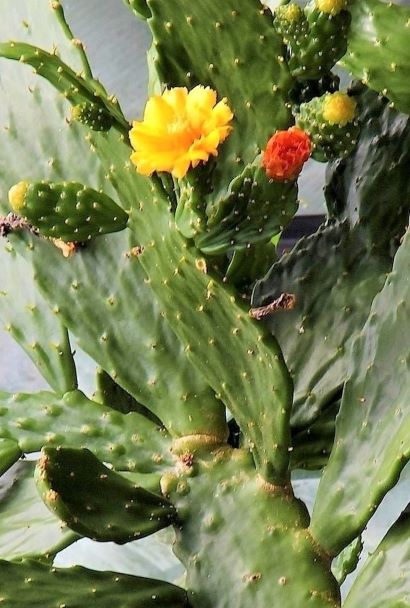In the diverse pantheon of cacti, the genus Consolea stands out not just for its aesthetic appeal but also for its fascinating biology and adaptability. Native to the arid landscapes of the Caribbean, particularly in areas like the Bahamas and Cuba, these unique cacti offer an intriguing glimpse into the complexities of desert flora. With their distinctive structures and survivability strategies, Consoleas prompt a shift in perspective on what we typically perceive cacti to be.
Delving into the world of Consolea is akin to opening a treasure chest filled with nature’s well-kept secrets. Understanding their characteristics, ecology, and cultivation can enrich the knowledge base of both seasoned botanists and enthusiastic gardeners. Let us embark on a journey to explore the captivating facets of Consolea cacti.
Visual Characteristics That Captivate
Consolea cacti are remarkable, not merely for the lush green of their pads but also for the extraordinary silhouettes they embody. At first glance, the absence of traditional “stem” structures might leave one bewildered; instead, they present a series of flat, paddle-like pads that branch out in an almost whimsical dance. These pads, known as cladodes, are not just for show; they play a critical role in the plant’s photosynthesis process, allowing it to thrive in sun-drenched environments.
In terms of morphological diversity, Consolea offers a spectrum ranging from smaller, bush-like forms to tall, tree-like structures. While some species maintain a compact stature, others can grow to impressive heights, casting much-needed shade on their surrounding ecosystems. The texture of Consolea’s pads can vary from smooth to spiny, contributing further to their allure. The spines, while serving a protective function against herbivores, also create a striking contrast against the vibrant green, adding an additional layer of visual depth.
Blooming Beauty: Flowers of the Consolea
No discussion of Consolea can be complete without acknowledging their floral displays. The flowers erupting from these unconventional cacti are nothing short of spectacular. Their blossoms usually manifest in colorful hues ranging from brilliant yellows to radiant pinks, attracting a myriad of pollinators, including bees and butterflies. This symbiotic relationship exemplifies the intricate dance of nature—where survival often hinges upon mutualism.
The blooming season can vary with climate conditions and specific species, but typically, Consolea flowers appear in the warmer months, often favoring times of heightened ecological interactions. The fleeting nature of their bloom amplifies the enchanting beauty of these plants; their flowers can last only a few days, urging observers to take a moment to appreciate their temporal splendor. Each bloom reveals the delicate balance that exists within ecosystems, showing how these cacti have adapted to both thrive and support a web of life.
Ecology and Habitat: A Testament to Resilience
Consolea cacti are a marvel of ecological adaptation, showcasing remarkable resilience to their harsh habitats. They predominantly inhabit rocky, well-drained soils, often characterized by low nutrient content—an environment in which few other plants can flourish. The secret lies in their evolution; Consoleas have developed specialized root systems that allow them to tap into deep water sources even in the driest of seasons.
Additionally, the design of their cladodes minimizes water loss, counteracting the relentless heat and aridity typical of their environments. Their skin, coated in a waxy layer, acts as a barrier against transpiration, ensuring moisture retention. These evolutionary adaptations provide vital lessons on survival tactics in extreme conditions, broadening our understanding of plant resilience.
Consolea cacti also play critical roles in their ecosystems. Their pads provide habitat for various organisms, from insects to birds, while their flowers serve as nectar sources during blooming periods. Moreover, these cacti shape the landscape, influencing soil composition and promoting biodiversity by supporting other flora and fauna. Observing Consolea in situ unlocks a richer understanding of ecological connectivity, making them significant players in the intricate web of life in arid regions.
Cultivation: Bringing Consolea to Your Garden
For those intrigued by the prospect of cultivating Consolea, these resilient plants can be a striking addition to any garden. They thrive in full sun and benefit from well-draining soil, making them ideal candidates for xeriscaping or rock gardens. Their limited water requirements align well with sustainable gardening practices, appealing to eco-conscious enthusiasts.
When planting Consolea, it is essential to consider their spacing needs, as some species can achieve considerable heights and breadths. Ensuring proper air circulation around the plants will mitigate issues related to rot and disease, which can thrive in overly humid conditions. Regular monitoring for pests, primarily scale insects and mealybugs, is crucial for maintaining plant health. A simple inspection can prevent infestations that could hinder growth or aesthetic appeal.
Propagation of Consolea can be accomplished through cuttings or seed germination, with the former being a popular method among gardeners seeking immediate results. Cuttings should be allowed to dry for a few days before planting, enabling calluses to form and reducing the risk of rot. Seeds require a warm environment for germination, often necessitating a period of stratification beforehand. Patience is essential, as both methods can take time before yielding a flourishing specimen.
Shifting Perspectives: Consolea in a Changing Climate
As climate change continues to alter landscapes and ecosystems worldwide, Consolea stands as a testament to adaptability and persistence. These cacti embody the ancient wisdom of evolution, showcasing traits that can inspire mindfulness in approaching environmental challenges. They represent not just the flora of the Caribbean but also a complex dialogue about resilience amidst changing ecological realities.
In summary, the Consolea genus reveals much about the beauty and complexity of desert life. Observing their growth, blooms, and adaptability shifts how we perceive cacti and their ecological roles. Engaging with these captivating plants elevates the experience of cultivating and understanding them, enriching the gardener’s journey. As we face an ever-evolving environmental landscape, Consolea cacti invite us to explore the intertwined narratives of survival and beauty within the natural world.

Leave a Comment